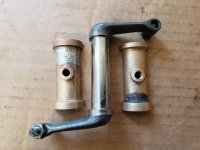This is for a Heavy 10L, but might be the same for all aprons.
I dug into the carriage to clean an adjust and found the rack pinion gear teeth badly worn. The cast iron bore in the apron is also badly worn. All the felt wicking was long gone. Fortunately the rack teeth seem OK.
The pinion shaft has approx 0.015" play in the apron casting. I can think of a few possible repair strategies - each with a downside.
Installing bushings would cause the loss of the felt keyway.
Plating and grinding the pinion shaft oversize would be expensive.
Making an oversize pinion shaft and somehow installing a gear - expensive or beyond my abilities.
What is the accepted repair?
Also, used South Bend pinion gears are sometimes available on line. Are the 14 tooth pinion gears the same for all the heavy 10-16" lathes? They have different part numbers (PT204R1, PT204T1, PT204F1, PT204H1).
My pinion gear is labeled P10, which means it is Plus 10 thousandths od - correct? Anyone have a replacement?

Thanks for you help and ideas,
Shawn
I dug into the carriage to clean an adjust and found the rack pinion gear teeth badly worn. The cast iron bore in the apron is also badly worn. All the felt wicking was long gone. Fortunately the rack teeth seem OK.
The pinion shaft has approx 0.015" play in the apron casting. I can think of a few possible repair strategies - each with a downside.
Installing bushings would cause the loss of the felt keyway.
Plating and grinding the pinion shaft oversize would be expensive.
Making an oversize pinion shaft and somehow installing a gear - expensive or beyond my abilities.
What is the accepted repair?
Also, used South Bend pinion gears are sometimes available on line. Are the 14 tooth pinion gears the same for all the heavy 10-16" lathes? They have different part numbers (PT204R1, PT204T1, PT204F1, PT204H1).
My pinion gear is labeled P10, which means it is Plus 10 thousandths od - correct? Anyone have a replacement?

Thanks for you help and ideas,
Shawn



 The handwheel has about 1/8 turn slop and about half seems to be the slop in the bore - and the end of the felt leaks a little oil. (a nice indicator it is working!)
The handwheel has about 1/8 turn slop and about half seems to be the slop in the bore - and the end of the felt leaks a little oil. (a nice indicator it is working!)

